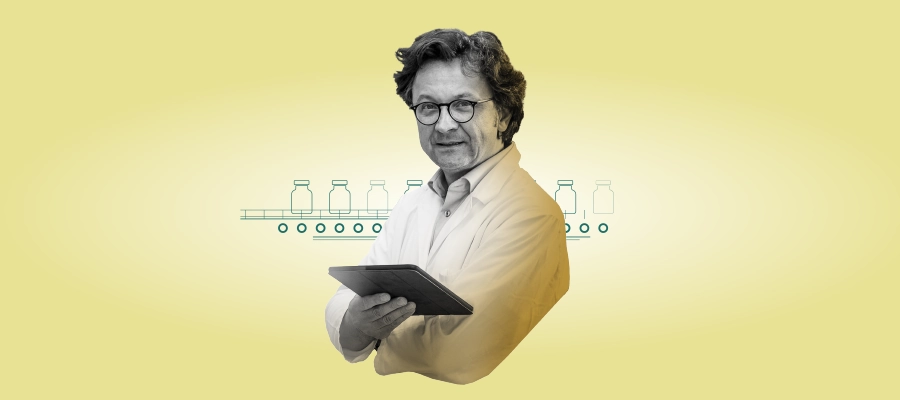
GxP Lifeline
How Electronic Logbooks Are Revolutionizing Environmental Monitoring in Pharma Manufacturing

Maintaining stringent environmental controls is crucial in the intricate landscape of pharmaceutical manufacturing. Clean room environments, essential for the production of sterile medicinal products, require meticulous monitoring to ensure the quality of products and patient safety. Traditional paper-based logbooks have long been used to record environmental parameters. However, the creation of electronic logbooks (e-logbooks) is changing environmental monitoring in pharmaceutical manufacturing, enhancing compliance-related processes, real-time data capture, and streamlined audit readiness.
A key area where this transformation is most evident is clean room monitoring. As the backbone of sterile pharmaceutical manufacturing, clean rooms require continuous oversight to ensure they meet regulatory standards and maintain product integrity. This is where electronic logbooks offer a distinct advantage, enabling more efficient, accurate, and compliant monitoring practices.
The first of an ongoing series, this blog post will look at the use of e-logbooks in clean room monitoring and the benefits they provide for pharma organizations.
Understanding the Role of Clean Room Monitoring in Pharma Manufacturing
Clean rooms are controlled environments with low levels of pollutants, such as dust, airborne microbes, and chemical vapors. In pharma manufacturing, they are critical for processes that require aseptic (completely containment-free environments) conditions. Environmental monitoring (EM) in these settings involves assessing the quality of air, surfaces, and personnel through microbial data collection. This process ensures that the manufacturing environment remains within specified cleanliness standards, keeping products sterile and safe for consumption.
According to the American Pharmaceutical Review1, EM programs should use a mix of the following methods for environmental monitoring:
- Settle plates.
- Contact plates.
- Surface/personnel swabs.
- Active air samples.
- Rinse samples.
A mix of these methods enables organizations to get a more accurate picture of how sterile clean rooms are and where, if any, improvements need to be made.
Traditional EM practices rely heavily on manual data entry into paper logbooks or Excel spreadsheets. While familiar, manual approaches are fraught with challenges, including illegible handwriting, data entry errors, delays in data availability, and the need to autoclave paper logbooks to sterilize them. Approximately 90% of all spreadsheets contain at least one error2, which can compromise the timely identification of environmental deviations, potentially impacting product quality.
To maintain sterility and compliance, pharma manufacturers must ensure all environmental monitoring data is accurate, complete, and easily accessible. This is where good manufacturing practice (GMP) regulations come into play — establishing a foundation for consistent and high-quality pharmaceutical production. Electronic logbooks align seamlessly with GMP requirements by automating data capture, reducing human error, and strengthening overall compliance.
Enhancing GMP Compliance With Digital Logbooks
GMP regulations provide pharma companies with the minimum standards necessary to ensure products are consistently high in quality. Both the U.S. Food and Drug Administration3 (FDA) and the European Medicines Agency4 (EMA) have established GMP guidelines that emphasize accurate documentation and data integrity.
As mentioned above, traditional logbooks introduce risks such as incomplete records, transcription errors, and unauthorized modifications, making compliance more challenging. Electronic logbooks directly address these challenges by digitizing environmental monitoring records, ensuring data integrity, security, and accessibility. This process helps manufacturers meet compliance standards by:
- Automatically capturing and storing environmental data, reducing the risk of human error associated with manual entries.
- Supporting electronic signatures, audit trails, and time-stamped entries, ensuring companies adhere to FDA and EMA electronic record-keeping regulations.
- Providing real-time access and transparency via regulatory inspectors and internal audits, which allow for the quick retrieval of records, improving audit readiness and minimizing compliance risks.
- Automatically alerting staff when environmental parameters exceed acceptable thresholds, enabling proactive corrective actions.
- Giving organizations access to secure, tamper-proof records, which reinforce compliance with ALCOA+ principles.
For example, MasterControl Logbooks software enables clean room operators to record environmental parameters in real-time using validated digital templates, automatically link entries to relevant standard operating procedures (SOPs), corrective actions/preventive actions (CAPAs), and deviation reports, and streamline audit preparation.
Learn more about FDA and ISO compliance for pharma manufacturers here.
Using E-Logbooks to Simplify Audit Readiness
Regulatory inspections by bodies such as the FDA and EMA are integral to verifying a manufacturer’s compliance with GMP. During these audits, inspectors scrutinize environmental monitoring records to ensure that manufacturing environments meet required standards. Traditional paper-based records are highly cumbersome to the audit process, which leads to potential delays and increased scrutiny from these regulatory bodies.
Electronic logbooks facilitate seamless audit readiness by organizing data in a centralized, easily retrievable manner. Enhancing data accuracy and legibility, eliminating issues associated with manual entries, and ensuring that records are readily available for inspection are key benefits of MasterControl’s e-logbook solution.
Additionally, e-logbooks can incorporate features such as mandatory fields, training checks, and correction logs, contributing to comprehensive traceability and data integrity. These elements are crucial for meeting regulatory standards and demonstrating a commitment to maintaining the highest quality in manufacturing processes.
Want more information on how to avoid failing compliance audits? Check out our eBook.
Capturing Environmental Parameters in Real-Time
Environmental monitoring in pharma manufacturing requires continuous data collection to ensure compliance and product safety. Traditional paper-based methods introduce delays in identifying deviations, increasing the risk of noncompliance and potential product recalls. For example, delayed detection of environmental fluctuations — such as temperature, humidity, or airborne particulate levels — can compromise sterile conditions and lead to costly investigations or product losses.
Real-time data capture with electronic logbooks eliminates these risks by providing instant visibility into environmental conditions. E-logbooks provide manufacturers with immediate access to environmental data, ensuring that deviations are identified and addressed before they escalate into compliance issues. With automated tracking and reporting, teams can respond proactively to ensure continuous adherence to GMP standards.
The Power of E-logbooks in Pharma Manufacturing
Using electronic logbooks in environmental monitoring practices is changing pharma manufacturing. By enhancing GMP compliance, streamlining audit readiness, and enabling real-time data capture, e-logbooks address the limitations of traditional paper-based systems and support the production of safe, high-quality pharmaceutical products.
As the industry continues to evolve, embracing digital solutions like electronic logbooks will be crucial for manufacturers aiming to maintain compliance, improve operational efficiency, and ensure the highest standards of product quality.
Ready to look deeper into how electronic logbooks can revolutionize manufacturing processes? Explore MasterControl’s Big Book of Logbooks. Our comprehensive guide provides valuable insights into the benefits and implementation of digital logbooks in the life sciences industry.
Want to unlock operational excellence in your pharmaceutical company? MasterControl Logbooks provide the efficiency, compliance, and quality needed to give your company a much-needed competitive edge.
Ready to learn more? Check out MasterControl’s digital logbooks or contact us for more information.
Resources
- “Limitations of Microbial Environmental Monitoring Methods in Cleanrooms”; Salaman-Byron, A.; American Pharmaceutical Review
- “Real-World Consequences of Manual Data Management”; Wreckler, B.; Charles River
- “Current Good Manufacturing Practice (CGMP) Regulations”; Food and Drug Administration
- “Good manufacturing practice | European Medicines Agency”; European Medicines Agency

